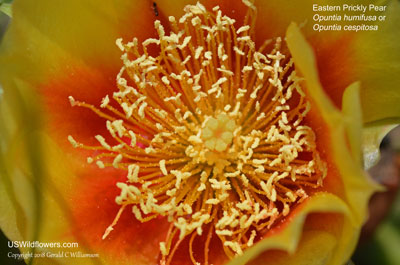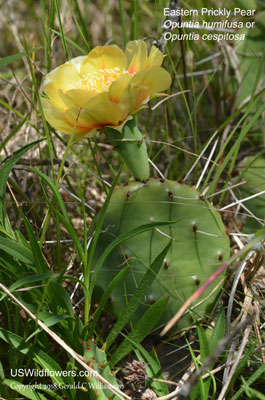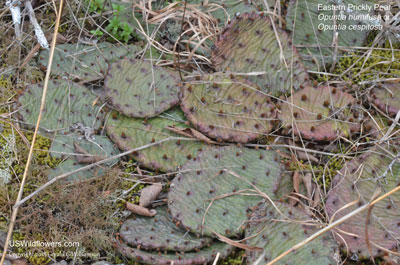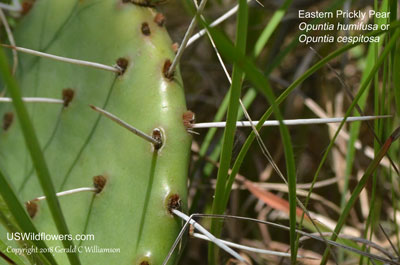Eastern Prickly Pear, Low Prickly Pear Cactus, Devil's Tongue, Indian Fig, Common Eastern Prickly Pear - Opuntia humifusa
|
Opuntia humifusa - Eastern Prickly Pear, Low Prickly Pear Cactus, Devil's Tongue, Indian Fig, Common Eastern Prickly Pear.
Opuntia - Prickly Pear - is the most widely distributed Cactus genus in the world, with somewhere between 150 and 200 species native to North and South America from Canada to Patagonia, and with a few species introduced in other parts of the world. There are over 30 species found in the United States - most in the west, but several found east of Texas. Most of these are in Florida, and a few in other southeastern coastal states. There are only one or two with significant distribution elsewhere in the east - Opuntia humifusa and if you subscribe to its separation from O. humifusa, Opuntia cespitosa.
For many years Opuntia humifusa was considered to be the only native cactus in Tennessee, where these photographs were taken. However, as Weakley's Flora of the Southern and Mid-Atlantic States says, "Opuntia species are notoriously difficult to identify," and with the return to species level O. cespitosa - which had been for so long considered to be contained within O. humifusa, the identification of O. mesacantha in western Tennessee, and the possibility that O. phaecantha is located in central Tennessee, O. humifusa may not be present in Tennessee at all, or nearly as widely distributed as it has been previously considered. While many authoritative descriptions still allow for O. humifusa to be in Tennessee with appearance as the plant shown here, most recent descriptions would imply that the plant shown here is instead O. cespitosa. However, since O. cespitosa is considered to be within the O. humifusa group of Opuntia, and it is not listed at all - synonym or otherwise - by many authoritative sources such as FNA, ITIS, NPIN, USDA, and BONAP, I am going to list this species here for now as Opuntia humifusa, and make note of some differences.
Found in:
AL, AR, CO, CT, DE, FL, GA, IA, IL, IN, KS, KY, LA, MA, MD, MI, MN, MO, MS, MT, NC, NE, NH, NJ, NM, NY, OH, OK, PA, RI, SC, SD, TN, TX, VA, WI, WV
Leave comments on Opuntia humifusa at this link. | 
Distribution of Opuntia humifusa in the United States and Canada:

Blue=Native; Grey=Introduced
Map from USDA Plants Database:
USDA, NRCS. 2017. The PLANTS Database (http://plants.usda.gov, 08 May 2025). National Plant Data Team, Greensboro, NC 27401-4901 USA.
Search Our Database: Enter any portion of the Scientific, Common Name, or both.
Do a general Google search of the entire site:
#ad
 Follow USWildflowers on Twitter
#ad
| | Site: Flat Rock Cedar Glades and Barrens State Natural Area, Rutherford County, TN Date: 2018-June-05 | Photographer: Gerald C Williamson
Nikon D7000 | | Eastern Prickly Pear has a beautiful flower with yellow tepals, sometimes reddish basally. The reddish coloration is one of the features used to separate the various Opuntia species. If you subcribe to separation of O. cespitosa from O. humifusa, O. cespitosa has basally reddish tepals; the tepals of O. humifusa are entirely yellow. | | 
| | Site: Flat Rock Cedar Glades and Barrens State Natural Area, Rutherford County, TN Date: 2018-June-05 | Photographer: Gerald C Williamson
Nikon D7000 | | The flowers of O. humifusa / O. cespitosa have pale yellow to creamy anthers held by yellow to orange filaments. The pollen is yellow. The stigma is yellow to white. O. phaecantha usually has a greenish stigma with basally-reddish yellow tepals. | | Click on the photo for a larger image

| | Site: Flat Rock Cedar Glades and Barrens State Natural Area, Rutherford County, TN Date: 2018-June-05 | Photographer: Gerald C. Williamson
Nikon D7000
Tamron SP 90MM f/2.8 AF Macro | | O. humifusa / O. cespitosa are low-growing shrubs. If you subscribe to separating the species, O. humifusa is spineless (a major diagnostic), while O. cespitosa has 0 to 3 spines per areole, usually with spines only on the upper part of the cladode (pad.) | | Click on the photo for a larger image

| | Site: Couchville Cedar Glade State Natural Area, Davidson County, TN Date: 2016-March-30 | Photographer: Gerald C Williamson
Nikon D7000 | | Most Opuntia species appear to dehydrate and wrinkle during the winter months. An exception is Opuntia phaecantha, which shares range with O. humifusa / O. cespitosa. The number of areoles in a diagonal across the wides part of the pad (cladode) are diagnostic to species. This will help differentiate between O. humifusa (4 or 5) from the similar O. mesacantha (3 - 4 areoles), both of which have entirely yellow tepals (assuming O. cespitosa is considered separate from O. humifusa. | | Click on the photo for a larger image

| | Site: Flat Rock Cedar Glades and Barrens State Natural Area, Rutherford County, TN Date: 2018-June-05 | Photographer: Gerald C Williamson
Nikon D7000 | | The tiny hair-like spines around the areoles of many cacti (or cactuses, which is also grammatically correct) - the ones that are likely to get stuck in your hand if you touch - are called glochids. Glochid characteristics are diagnostics for Opuntia species - color, length, location. The glochids on O. humifusa are pale yellow to light brown; those of O. cespitosa are darker brown to red. | | Click on the photo for a larger image

|
References used for identification and information:
|
|
| |
| #ad
|
|







